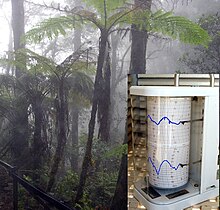Dew point
| Humidity and hygrometry | |
|---|---|
 |
|
| Specific concepts | |
|
|
| General concepts | |
| Measures and Instruments | |
Dew point is the temperature at which airborne water vapor will condense to form liquid dew. A higher dew point means there will be more moisture in the air. Dew point is sometimes called frost point when the temperature is below freezing. The measurement of dew point is related to humidity.
Given that all the other factors influencing humidity remain constant, at ground level the relative humidity rises as the temperature falls. This is because more water vapor condenses as the temperature falls. Dew point temperature is never greater than the air temperature because relative humidity cannot exceed 100%.
In technical terms, the dew point is the temperature at which the water vapor in a sample of air at constant barometric pressure condenses into liquid water at the same rate at which it evaporates. At temperatures below the dew point, the rate of condensation will be greater than that of evaporation, forming more liquid water. The condensed water is called dew when it forms on a solid surface. The condensed water is called either fog or a cloud, depending on its altitude, when it forms in the air.
A high relative humidity implies that the dew point is closer to the current air temperature. Relative humidity of 100% indicates the dew point is equal to the current temperature and that the air is maximally saturated with water. When the moisture content remains constant and temperature increases, relative humidity decreases.
General aviation pilots use dew point data to calculate the likelihood of carburetor icing and fog, and to estimate the height of a cumuliform cloud base.
At a given temperature but independent of barometric pressure, the dew point is a consequence of the absolute humidity, the mass of water per unit volume of air. If both the temperature and pressure rise, however, the dew point will increase and the relative humidity will decrease accordingly. Reducing the absolute humidity without changing other variables will bring the dew point back down to its initial value. In the same way, increasing the absolute humidity after a temperature drop brings the dew point back down to its initial level. If the temperature rises in conditions of constant pressure, then the dew point will remain constant but the relative humidity will drop. For this reason, a constant relative humidity with different temperatures implies that when it is hotter, a higher fraction of the air is present as water vapor compared to when it is cooler.
...
Wikipedia
